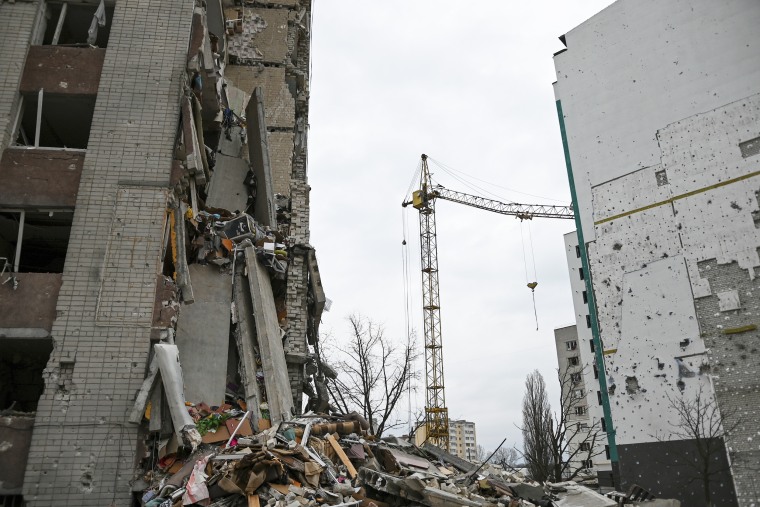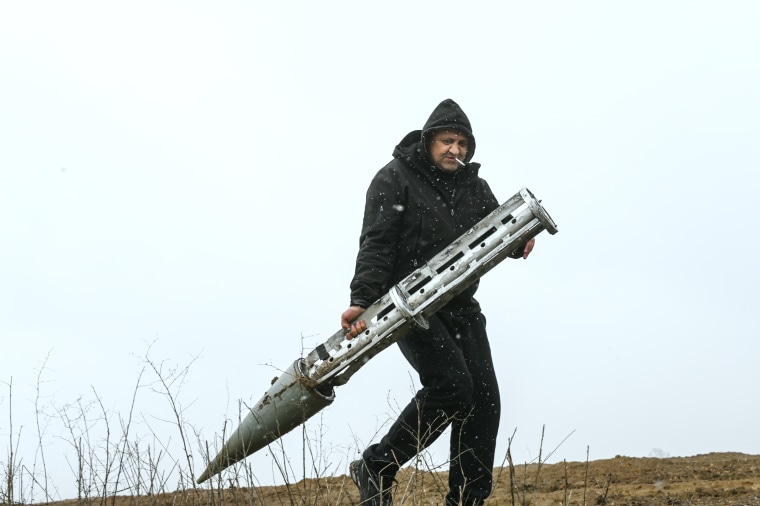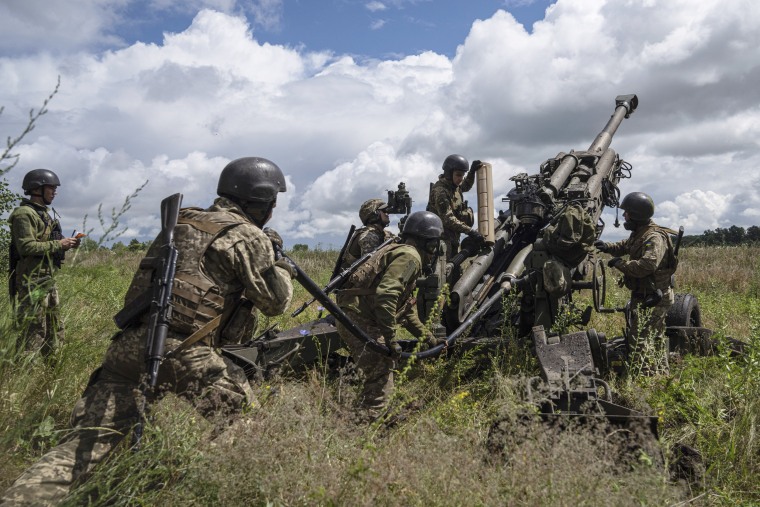More than 120 countries have banned their use — Congress and human rights groups lambasted Russia for firing them last year, and the White House has resisted pressure to send them for months. But now, the U.S. is seriously considering the idea of providing the Ukrainian military with cluster bombs.
Two senior U.S. officials told NBC News Thursday that an announcement could come as early as next month, and Army Gen. Mark Milley, chairman of the Joint Chiefs of Staff, speaking at an event at the National Press Club in Washington, D.C., on Friday, said the U.S. was mulling the idea of providing the capability to Ukraine, which he said other allies had previously done.
“The Ukrainians have asked for it, other European countries have provided some of that, the Russians are using it — there’s a decision-making process ongoing,” Milley said.
While such a decision has been applauded by a bipartisan group in Congress, it has also raised the ire of some Democrats and human rights groups.
Cluster bombs, known as dual-purpose improved conventional munitions, or DPICMs, are projectiles that are fired from an artillery unit or aircraft. Inside are small bomblets that disperse across a large area on a battlefield, causing widespread destruction. They can be charges aimed at penetrating armored vehicles, or they can shatter or fragment to be more dangerous to people.
They are so effective that they can turn the trenches of a frozen conflict into “killing zones,” according to a report published in 2019 by the Royal United Services Institute, or RUSI, a British military think tank. The problem is that they can sometimes create a minefield of unexploded, untracked bomblets. These “duds” can be difficult to clean up and can explode years later, injuring or killing civilians or other unintended targets long after a war has concluded.
Worldwide, civilians represented 97% of all cluster munition casualties, according to a report in August by the Landmine and Cluster Munition Monitor, a campaign group that works to eradicate their use. Children accounted for 66% of all casualties where the age group was known, the report said.

Their use by both sides has been documented during the war in Ukraine, according to Human Rights Watch, an international nongovernmental organization. It is unknown how many people the munitions have killed or how large an area might be affected, but Ukrainian Prime Minister Denys Shmyhal said in April that more than 67,000 square miles of the country had been blighted by unexploded ordnance. In Ukraine, they killed 226 people in March alone, according to Shmyhal.
Long in need of more artillery rounds, Ukraine has requested the destructive shells for more than a year, but President Joe Biden and his administration have hesitated and remained on the brink of destroying thousands of cluster munition shells that have a “dud” rate of over 1% and are close to expiring in American stockpiles — a move that would have been applauded by humanitarian groups.
But a congressional aide who has worked to push forward the discussion about sending the cluster rounds to Ukraine confirmed that the U.S. now appears to be ready to ship the munitions. They have long been at the top of Kyiv’s wish list, and American military policy still relies upon them, the aide said.
“If we feel this is the kind of thing that we could man, train, equip our own forces with, there’s absolutely no reason why they shouldn’t go to Ukraine,” said the aide, who requested anonymity to speak freely about ongoing deliberations.
A debate in Congress
Last year, 27 Democratic House members sent a letter to Biden pleading for him to join the Convention on Cluster Munitions, an international treaty that bans the transfer and use of the cluster rounds. That view has not disappeared, though it has grown to acknowledge the talk in Washington about what to do with America’s stockpile of cluster bombs.
Fourteen senators sent a letter to Biden’s national security adviser, Jake Sullivan, last week that said that while they recognize the munitions could provide Ukraine an advantage on the battlefield, “we are convinced that the humanitarian costs and damage to coalition unity of providing U.S. cluster munitions would outweigh the tactical benefits.”
Many American allies have signed on to the Convention on Cluster Munitions. Of the 31 NATO countries, only Estonia, Greece, Latvia, Poland, Romania, Turkey and the U.S. are not signatories. An unofficial American policy, however, has long limited sharing the capability with other nations and sought to reduce the use of cluster munitions.
When Russia stood accused of using cluster rounds last year in Ukraine, NATO Secretary General Jens Stoltenberg declared the act “inhumane” and “in violation” of international law, although neither Ukraine or Russia are signatories of the convention.

But over the past year, members of Congress have been privy to private briefings from U.S. military officials, and that appears to have encouraged their support.
The Pentagon sent its top official focused on Russia, Ukraine and Eurasia to testify before Congress last month about cluster bombs. Deputy Assistant Secretary for Defense Laura Cooper, one of several Pentagon officials who spoke to Congress, told members that “our military analysts have confirmed that DPICMs would be useful, especially against dug-in Russian positions on the battlefield.”
For members of Congress without military expertise, “hearing that validation really helped move the needle,” the congressional aide said.
A bipartisan group in Congress sent a letter to Biden last month, encouraging him to provide the weapons. The group noted that the U.S. developed cluster munitions during the Cold War “to counter Russia’s numerical and material superiority.”
“Now they can be put to their intended use in Ukraine’s defense — and Ukraine’s defense of Europe, and ultimately, U.S. national security,” the letter said.
While support for providing these arms has grown on both sides of the aisle in recent months, rights groups and some Democrats say the human cost will outweigh the benefit.
“This is what militaries say,” Mary Wareham, the arms advocacy director at Human Rights Watch, said. “Any weapon would be useful. Chemical weapons would be useful. Cluster munitions for us are in the same category as chemical weapons and are prohibited for a very specific reason, because of the civilian harm and the human suffering that’s brought by them.”
She added that the White House did not respond to letters sent by Human Rights Watch and a coalition of nongovernmental organizations opposed to sending cluster munitions.
There also appears to have been other private briefings for members of Congress that may have further helped move the needle.
Rep. Jason Crow, D-Colo., sent a letter to Defense Secretary Lloyd Austin that requested that the Pentagon make information about cluster munitions “publicly available.” He also raised the issue of “dud” rates, when the bomblets don’t explode.
U.S. policy does not allow the transfer of cluster munitions with a dud rate over over 1%, according to the Foreign Assistance Act. Under Secretary of Defense for Policy Colin Kahl admitted on a podcast in February that some of the rounds in the U.S. arsenal have a rate that is just north of that number, though in 2008 the Army ceased procurement of cluster munitions because the dud rate was as high as 5%.
Concerns in Congress over the dud rate appear to have been assuaged in private briefings somehow, said Wareham, mystifying her and members of other human rights groups.
“Without having the information that the Pentagon is giving to them, it’s hard for us to understand some of the claims that are being made, but they’re pretty outlandish,” she said. “A lot of the groups and members of Congress that are saying to send cluster munitions to Ukraine were never demanding that for previous wars and conflicts. It’s just Ukraine at this moment of time. It’s kind of wild to see.”
It remains to be seen when or if the munitions will ultimately be sent.
John Kirby, spokesperson for the National Security Council, declined to comment about the White House’s plans for the cluster rounds on Friday but said they continue to “work in lockstep with the Ukrainians here every day.”
“We’re going to continue to have those conversations with the Ukrainians going forward and as we have over the last 16 months,” he said. “We’ll continue to review those requests and adapt as appropriate, but I just don’t have a decision or announcement on anything new today.”

